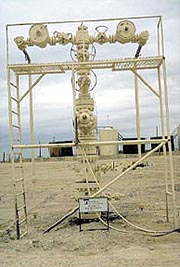
The new projects - to be carried out by Advanced Resources International, Arlington, Va., and Cementing Solutions, Houston - were selected for federal cost-sharing when Congress increased DOE's budget for natural gas research in fiscal year 2002. They will join two earlier projects selected last August. All four projects had been proposed in an industry-wide competition run earlier this year by the Energy Department's Strategic Center for Natural Gas, part of the government's National Energy Technology Laboratory.
Developing new technologies that can tap low-permeability gas-bearing formations is likely to become increasing important as the nation's gas demand expands in coming years. President Bush's National Energy Policy cautions that production from conventional gas sources could peak within the next 15 years, and domestic gas producers likely will turn to harder-to-produce unconventional reservoirs to meet demand.
If successful, new technologies could add trillions of cubic feet of natural gas to the nation's gas supply. Much of the nation's low-permeability gas formations are found at depths greater than 15,000 feet. Many of these formations lack an extensive, well-connected network of natural fractures through which the gas can flow to producing wells.
Also, gas producers are increasingly encountering surprising levels of water production from formations where water was not expected to be a problem. Many operators are thinking twice about developing certain areas where excessive water production has been encountered.
The new projects focus specifically on these challenges. Together, the projects are valued at nearly $1.6 million.
Water Problems
The project being conducted by Advanced Resources International represents the first in-depth, comprehensive attempt to understand and address water-production dilemmas of gas fields in the Rocky Mountains.Unwanted water production adds costs for disposal, reduces gas production and increases the risks of natural gas exploration and development in these promising formations. And little is known about what causes high water production, its sources and flow paths. Consequently, no consistent strategies now address this problem. The presence of mobile water and high water production is becoming more of a problem in major gas producing basins.
Specifically, the proposal sets out to accomplish three goals:
1) Build a regional database on water composition and chemistry for key Rocky Mountain gas basins.
2) Identify sources and waterways that are located in close proximity to natural gas formations.
3) Verify regional water storage, flow models and field tests to avoid or mitigate high water production.
Zone Isolation
Cementing Solutions is working on a project that will examine several aspects of zone isolation to increase gas production from low-permeability reservoirs. Gas is harvested by drilling a borehole, inserting a steel casing and injecting cement between the casing and reservoir, thereby isolating a "zone." The zone is then perforated - holes are shot through the casing and cement - and water-based fluid and sand are pumped through the perforations to create vertical fractures through which gas flows. At times, the rock formation containing natural gas may be damaged, making it more difficult to recover the fuel.This projects looks at how to achieve good zone isolation. Experimental results and mathematical modeling will be fed into a computer-based, best-practice decision matrix, which will permit gas producers to evaluate the best types of cements, properties and placement methods that maximize gas stimulation and minimize formation damage.
These strategies will be followed throughout the course of the project:
1) Determine the effectiveness of zone isolation for establishing effective pressure isolation (a hydraulic seal).
2) Use post-fracture-treatment data to confirm how well the hydraulic seal prevents near wellbore fracturing out of a zone.
3) Measure the lost production from low-permeability reservoirs because of the effects of fluid invasion during cementing.
4) Assess procedures to seal in vertical wells to determine if these procedures could be successfully applied to horizontal wells.
Report Abusive Comment